

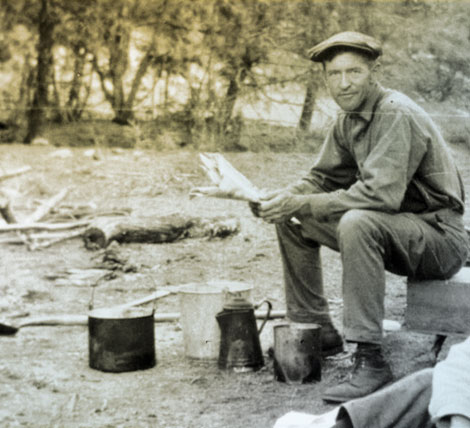 William H. Bartlett came to Arizona in 1888 at the age of nine. He later helped organize the Verde River Irrigation and Power District. For 10 years, he served as the District's field engineer and for 33 years as secretary. He is credited with discovering the dam site while surveying the Verde River. His knowledge of the river and its surrounding topography was unsurpassed. Bartlett lived and worked in the Phoenix area until he died in June 1966. (Courtesy of Salt River Project)
William H. Bartlett came to Arizona in 1888 at the age of nine. He later helped organize the Verde River Irrigation and Power District. For 10 years, he served as the District's field engineer and for 33 years as secretary. He is credited with discovering the dam site while surveying the Verde River. His knowledge of the river and its surrounding topography was unsurpassed. Bartlett lived and worked in the Phoenix area until he died in June 1966. (Courtesy of Salt River Project)As the 19th century slipped into the 20th, water storage works on the Verde River, as on all Central Arizona rivers, became a contested dream for many people. For over 22 years, two irrigation groups, the Paradise Verde Irrigation District and the Salt River Valley Water Users Association (Association) battled each other over use of Verde River water in court and in the press. It was a complex and involved case, but in the end, the Great Depression and other factors ultimately resulted in the Association claiming victory when the Bureau of Reclamation was authorized to build a new dam on the Verde.
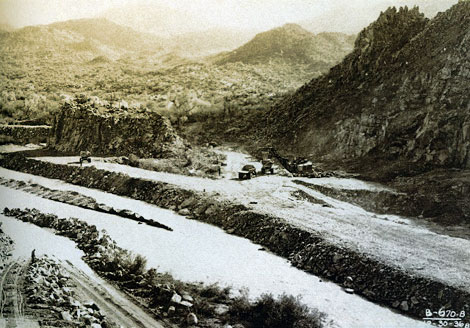 Construction beginning on abutment for the dam 1936. (Courtesy of Salt River Project)
Construction beginning on abutment for the dam 1936. (Courtesy of Salt River Project)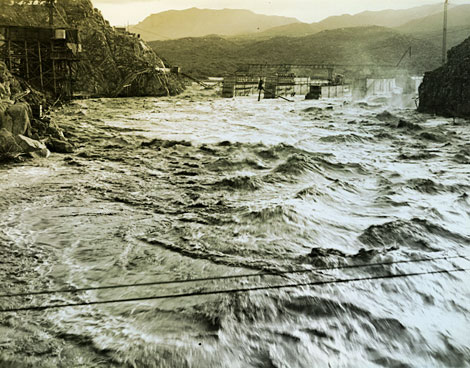 During the morning of March 4, 1938, the Verde River rampaged through the construction site. This photograph was taken on around 9:00 AM. The river was discharging about 79,000 feet per second. (Courtesy of Salt River Project)
During the morning of March 4, 1938, the Verde River rampaged through the construction site. This photograph was taken on around 9:00 AM. The river was discharging about 79,000 feet per second. (Courtesy of Salt River Project)Bartlett Dam would become the fifth dam in the Salt River Project and the third dam built by Reclamation (Roosevelt and Granite Reef Diversion dams were the other two). It would be Reclamation's first attempt at a multiple arch, hollow-buttress design and, when completed, would be the highest dam of its type in the United States. The design was selected because it offered financial advantages. While the multiple-arch design required more labor than conventional dams due to its sophisticated concrete forms—an advantage in work-depressed Arizona—its hollow and thin buttresses and arches required less materials, resulting in cheaper freight costs. (At this time, Arizona had four multiple arch dams: Gillespie and Coolidge on the Gila River, Cave Creek on the nearby wash of the same name, and Waddell on the Agua Fria River.) Originally designed by the Association's consulting engineer Raymond Hill, the final design was completed by Reclamation Construction Engineer Edward C. Koppen. It contained some unprecedented design and construction features, including cylindrical full half-circle arches, a design that allowed it to curve upstream to fit the topography. Buttresses were built with contraction joints, which are 18-inch saw-tooth openings that were later filled after the heat of the setting concrete had dissipated. This was done to avoid the concrete cracking problems that plagued Waddell Dam. Each buttress also included, at forty-one foot vertical intervals, two 18-inch stiffener walls between sides.
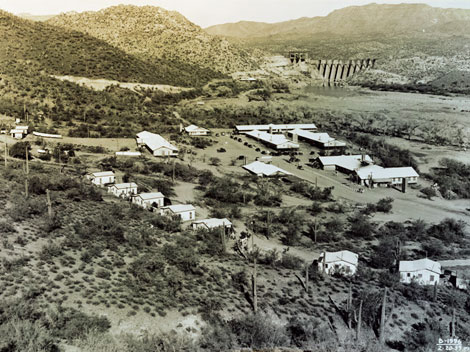 The photograph shows the construction camp where Reclamation staff and the contractor's work force lived. Essentially a small town, the camp had a school, post office, infirmary, mess hall, barracks, married housing quarters, workshops, and offices. (Courtesy of Salt River Project)
The photograph shows the construction camp where Reclamation staff and the contractor's work force lived. Essentially a small town, the camp had a school, post office, infirmary, mess hall, barracks, married housing quarters, workshops, and offices. (Courtesy of Salt River Project)Design work for Bartlett was completed in spring of 1936. On August 12, the contract was awarded, with the specification that the contractor complete the work in 1,000 days, or by May 9, 1939. Once on site, the contractor built roads around the site and a construction camp; months earlier the Association had constructed a primary access road and a 16.75 mile-long transmission line to the site. The contractor's camp housed two hundred men and fifteen families in various kinds of dormitories. At the same time, Reclamation built a camp for its staff, and installed a phone system to connect with Phoenix. By year's end construction was 8.3% complete much to Reclamation's and the Association's delight.
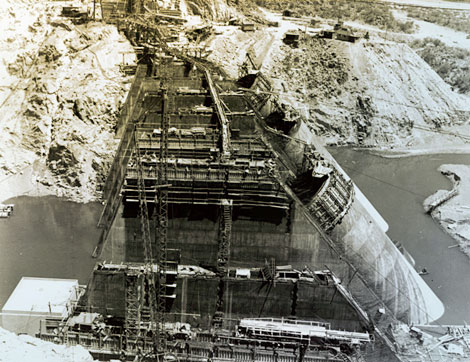 Construction was well underway by 1938. This photograph shows on-going construction of the multiple arches. Low heat cement was used in the concrete to speed up construction, and a system of fog-spray nozzles continuously cooled the concrete by evaporation. (Courtesy of Salt River Project)
Construction was well underway by 1938. This photograph shows on-going construction of the multiple arches. Low heat cement was used in the concrete to speed up construction, and a system of fog-spray nozzles continuously cooled the concrete by evaporation. (Courtesy of Salt River Project)Delight turned to despair during the winter of 1936-1937. Several floods, including the largest then recorded, ravaged the construction site. The contractor spent most of the year drying and re-excavating abutments, foundations, and building–then rebuilding three times–failed cofferdams. These efforts continued to fail until the contractor re-routed the river by building two cofferdams upstream and downstream of the site, then carrying the river flow around the construction site through six-foot steel pipes. When not trying to control the raging river, the contractor excavated all of the buttresses, trimmed the spillway sidewalls, and removed overburden from the abutment down to the top of the cut-off trenches and buttress footing trenches, while a subcontractor performed grouting and filling work to firm up the dam's foundation. By the end of a very wet 1937, the dam had not even reached stream bed elevation: only 51,000 cubic yards of concrete had been placed and 38 percent of the work completed.
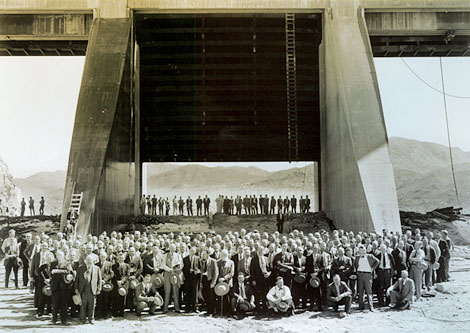 Reclamation and contractor personnel pose beneath one of three Stoney gates in this 1939 photograph. Each Stoney gate was 50 feet by 50 feet, weighed 200 tons, and could be raised about 4 inches per minute. (Courtesy of Salt River Project)
Reclamation and contractor personnel pose beneath one of three Stoney gates in this 1939 photograph. Each Stoney gate was 50 feet by 50 feet, weighed 200 tons, and could be raised about 4 inches per minute. (Courtesy of Salt River Project)Despite another massive flood on March 4, 1938, that measured a whopping 108,000 cubic feet per second peak flow, work progressed on the dam. The spring flood did little damage because all the arches, save one, were above the stream bed. Despite losing some time, the contractor felt more secure because it had insured itself for flood damages. They spent the rest of the year placing concrete to elevate the buttresses and arches. By the end of 1938, the contractor had poured 122,446 yards of concrete with only an estimated 7,720 cubic yards remaining to complete the dam. But in response to the flooding delays, the contractor looked for ways to speed up construction to meet the 1,000-day window. They discovered the process was much faster if they could pour concrete for consecutive or adjacent arches instead of working either side of the dam. The contractors also used a light mist fog spray to help cool the curing concrete, something they had to clear with Reclamation before doing. Buttress and arch work forms were steel, except for those used at the lower elevations. There, timber was used, as it was also used to form the gravity sections and parts of the spillway. Some of these forms weighed as much as 38 tons, and were raised from a ten-ton cableway that spanned 1,140 feet across the canyon.
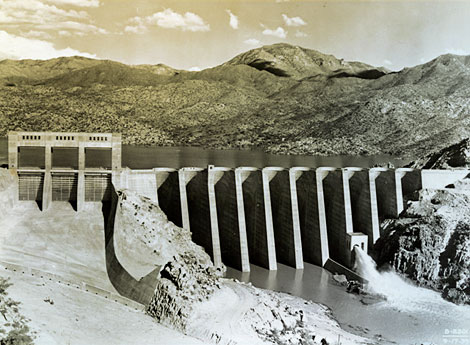 Bartlett Dam was completed May 9, 1939 in less than 1,000 days and $270,000 under budget. (Courtesy of Salt River Project)
Bartlett Dam was completed May 9, 1939 in less than 1,000 days and $270,000 under budget. (Courtesy of Salt River Project)Despite wet weather and floods, Bartlett Dam was completed in May 1939. The contractor had met its 1,000-day deadline! Furthermore, the final tab was approximately $270,000 less than estimated. The structure's innovative design, use of fog mist to pour concrete in hot weather, and use of low-heat cement resulted in a nearly flawless, monolithic structure. In October 1939, Reclamation turned over operations and maintenance of Bartlett to the Association under a June 3, 1935 contract signed by the Association and the United States.
The Association had agreed under its 1917 contract with the U.S. that it would cooperate in providing water for 6,310 acres for the Salt River Pima Indians. As a result, 20% of the dam's construction cost was paid for by the federal government to provide 20% of the dam's storage capacity for the Salt River Indian Reservation some 20 miles downstream of the dam. The Association agreed to pay the remaining 80% and operate and maintain the dam.
Bartlett Dam would provide no hydropower. It was to be used solely to store irrigation water, a nod to the many Valley farmers who felt the Association was more interested in generating more profitable electricity than providing irrigation water.
